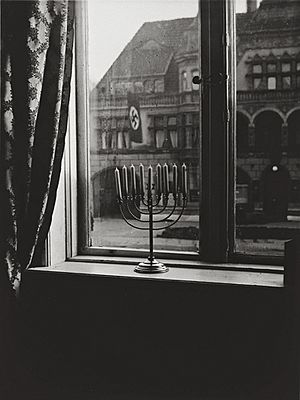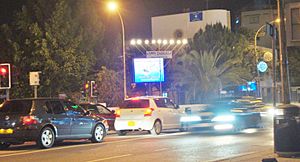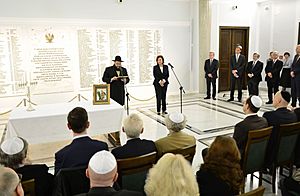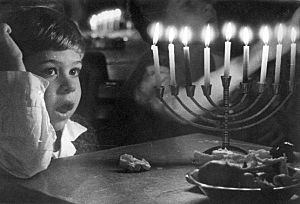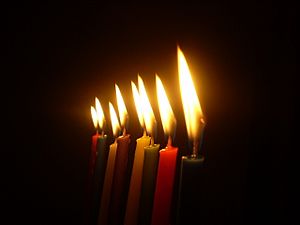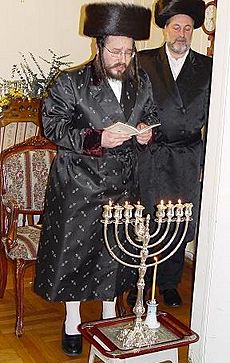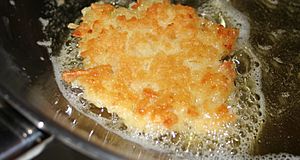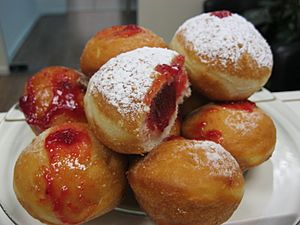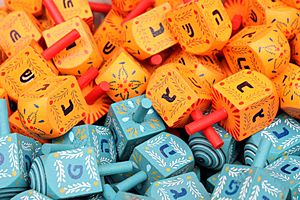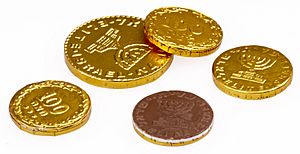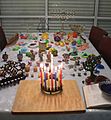Hanukkah facts for kids
Quick facts for kids Hanukkah |
|
|---|---|
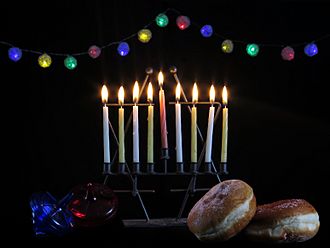
|
|
| Official name | חֲנֻכָּה or חֲנוּכָּה English translation: 'Establishing' or 'Dedication' (of the Temple in Jerusalem) |
| Observed by | Jews |
| Type | Jewish |
| Significance | The Maccabees successfully revolted against Antiochus IV Epiphanes. According to the Talmud, the Temple was purified and the wicks of the menorah miraculously burned for eight days, even though there was only enough sacred oil for one day's lighting. |
| Celebrations | Lighting candles each night. Singing special songs, such as Ma'oz Tzur. Reciting the Hallel prayer. Eating food fried in oil, such as latkes and sufganiyot, and dairy foods. Playing the dreidel game, and giving Hanukkah gelt |
| Begins | 25 Kislev |
| Ends | 2 Tevet or 3 Tevet |
| Date | 25 Kislev, 26 Kislev, 27 Kislev, 28 Kislev, 29 Kislev, 30 Kislev, 1 Tevet, 2 Tevet, 3 Tevet |
| 2023 date | Sunset, 7 December – nightfall, 15 December |
| 2024 date | Sunset, 25 December – nightfall, 2 January |
| 2025 date | Sunset, 14 December – nightfall, 22 December |
| 2026 date | Sunset, 4 December – nightfall, 12 December |
| Related to | Purim, as a rabbinically decreed holiday. |

Hanukkah is a special Jewish holiday that lasts for eight days. It celebrates two important events. First, it remembers the victory of a small group of Jewish fighters, called the Maccabees, over a much larger Syrian army. Second, it celebrates a miracle that happened during this time.
After the Maccabees won, they wanted to make their Temple in Jerusalem holy again. They found only a tiny bit of oil to light the menorah, a special lamp. This oil was only enough for one day. But, amazingly, the menorah stayed lit for eight days! This was seen as a miracle from God. Because of this miracle, Jewish people celebrate Hanukkah for eight days. The holiday starts on the 25th day of Kislev in the Hebrew calendar. This usually falls in late November or December on the Gregorian calendar. The Hebrew word Hanukkah means 'dedication' or 'establishing'.
A hanukiah is a special candle holder used during Hanukkah. It has nine branches. One candle, called the shamash (meaning "attendant" or "helper"), is usually set apart, often a bit higher. This shamash candle is used to light the other eight candles.
On the first night, one candle is lit on the right side. On the second night, a second candle is added to the left of the first, but they are lit from left to right. This pattern continues for all eight nights. Blessings are said while the candles are lit.
Jewish children often play a game with a dreidel. A dreidel is a four-sided spinning top with Hebrew letters on each side. These letters stand for "Nes gadol haya shaam," which means "A great miracle happened there." In Israel, the letters mean "A great miracle happened here."
Contents
The Story of Hanukkah
Approximately 2,200 years ago, there was a conflict between the Greeks and the Jewish people. The Greeks won and tried to make the Jews adopt their culture. A group of Jewish fighters, known as the Maccabees, fought back. They successfully took back Jerusalem.
When the Maccabees entered their Temple, they found it had been made unclean. The Greeks had used it to worship their god, Zeus. The Maccabees wanted to make the Temple holy again and dedicate it to God. Part of this rededication involved relighting the menorah, which needed pure olive oil.
According to the Talmud, a collection of Jewish teachings, the Maccabees found only one small jar of pure oil. This oil was just enough to keep the menorah lit for one day. However, they decided to light it anyway, trusting in God. To their surprise, the menorah stayed lit for eight full days! This was seven days longer than expected. Jewish people believe this was a miracle from God.
Hanukkah is an eight-day celebration. Each day remembers one of the days the oil miraculously lasted. Every night, a branch of the nine-branch Hanukkah menorah is lit using the shamash or "helper" candle.
How Hanukkah is Celebrated
Hanukkah is celebrated with many traditions that happen every day of the eight-day holiday. Some traditions are done with family, and others are done with the community. Special prayers are added to the daily services, and a section is added to the blessing after meals.
Hanukkah is not like the Sabbath, so people can still do their usual activities. Many people go to work or school as normal. However, in Israel, schools close for most of Hanukkah. Many families give gifts to each other each night, like books or games. Children often receive "Hanukkah Gelt," which is money.
Foods fried in oil are eaten to remember the miracle of the oil. These include latkes (potato pancakes) and sufganiyot (jelly doughnuts). Some people also eat dairy foods during Hanukkah.
Lighting the Hanukkah Lights
Each night, a candle or oil lamp is lit. The number of lights increases by one each night. An extra light, the shamash, is also lit every night. It is placed in a special spot, usually higher or to the side.
The shamash is important because the other Hanukkah lights are not meant for regular use. They are only for remembering and sharing the Hanukkah miracle. If someone needs more light, they use the shamash candle. Some people light the shamash first and then use it to light the other candles.
By the last night, nine lights are lit (eight Hanukkah lights plus the shamash). Over the eight days, a total of 44 lights are lit. Most Jewish homes have a special candle holder called a Chanukiah or menorah. Many families also use oil lamps, traditionally with olive oil.
In the United States, public Hanukkah celebrations became more common in the 1970s. This was encouraged by Rabbi Menachem M. Schneerson, who wanted more people to know about the holiday.
The Hanukkah lights are meant to be seen by people outside the home. This helps to share the story of the miracle. So, lamps are often placed in a window or near the door facing the street.
When to Light the Candles
Hanukkah lights should burn for at least half an hour after dark. Many people light them at sundown. Some Jewish groups, like the Hasidim, light them later. They do this so more people can be there to see the lights and remember the miracle.
Small wax candles sold for Hanukkah usually burn for about half an hour. So, they should not be lit too early.
Blessings for the Candles
Two blessings are usually said when lighting the candles during Hanukkah. On the first night, a third blessing, the shehecheyanu blessing, is added.
The blessings are said either before or after lighting the candles, depending on family tradition. On the first night, one light is placed on the right side of the menorah. On the next night, a second light is placed to the left of the first. However, the candles are lit from left to right over the eight nights.
- Blessing for lighting the candles:
בָּרוּךְ אַתָּה ה', אֱ-לֹהֵינוּ מֶלֶךְ הָעוֹלָם, אֲשֶׁר קִדְּשָׁנוּ בְּמִצְוֹתָיו, וְצִוָּנוּ לְהַדְלִיק נֵר חֲנֻכָּה.
Transliteration: Barukh ata Adonai Eloheinu, melekh ha'olam, asher kid'shanu b'mitzvotav v'tzivanu l'hadlik ner Hanukkah. Translation: "Blessed are You, LORD our God, King of the universe, Who has made us holy with His commandments and commanded us to light the Hanukkah light[s]."
- Blessing for the miracles of Hanukkah:
בָּרוּךְ אַתָּה ה' אֱ-לֹהֵינוּ מֶלֶךְ הָעוֹלָם, שֶׁעָשָׂה נִסִּים לַאֲבוֹתֵֽינוּ בַּיָּמִים הָהֵם בַּזְּמַן הַזֶּה.
Transliteration: Barukh ata Adonai Eloheinu, melekh ha'olam, she'asa nisim la'avoteinu ba'yamim ha'heim ba'z'man ha'ze. Translation: "Blessed are You, LORD our God, King of the universe, Who performed miracles for our ancestors in those days at this time..."
Hanerot Halalu
After the lights are lit, a hymn called Hanerot Halalu is recited. Here is a common version:
| Hebrew | Transliteration | English |
|---|---|---|
| הנרות הללו אנו מדליקין על הנסים ועל הנפלאות ועל התשועות ועל המלחמות שעשית לאבותינו בימים ההם, בזמן הזה על ידי כהניך הקדושים. וכל שמונת ימי חנוכה הנרות הללו קודש הם, ואין לנו רשות להשתמש בהם אלא להאיר אותם בלבד כדי להודות ולהלל לשמך הגדול על נסיך ועל נפלאותיך ועל ישועותיך. | Hanneirot hallalu anu madlikin 'al hannissim ve'al hanniflaot 'al hatteshu'ot ve'al hammilchamot she'asita laavoteinu bayyamim haheim, (u)bazzeman hazeh 'al yedei kohanekha hakkedoshim. Vekhol-shemonat yemei Hanukkah hanneirot hallalu kodesh heim, ve-ein lanu reshut lehishtammesh baheim ella lir'otam bilvad kedei lehodot ul'halleil leshimcha haggadol 'al nissekha ve'al nifleotekha ve'al yeshu'otekha. | We light these candles for the miracles and wonders. We light them for the help and battles You gave our ancestors. This happened in those days, at this time, through Your holy priests. During all eight days of Hanukkah, these lights are sacred. We are not allowed to use them for everyday things. We only look at them to thank and praise Your great Name. We thank You for Your miracles, Your wonders, and Your salvation. |
Maoz Tzur Song
In the Ashkenazi tradition, after lighting the candles each night, people sing the hymn Ma'oz Tzur. This song has six parts. The first and last parts talk about God's help in general. The middle four parts talk about times when Jewish people faced hardship throughout Jewish history. They praise God for helping them survive these difficult times. These events include the the exodus from Egypt, the Babylonian captivity, the miracle of Purim, and the Hasmonean victory. The song also expresses a hope for a future victory.
The song was written in the 1200s by a poet named Mordechai. The tune is likely from an old German church hymn or a folk song.
Special Prayers During Hanukkah
A special prayer called Al HaNissim ("On the Miracles") is added to the daily prayers. This prayer talks about the victory of the Hasmonean Mattathias and his sons over the Syrians.
This same prayer is also added to the blessing said after meals. Additionally, the Hallel (praise) Psalms (Psalm 113 – Psalm 118) are sung each morning. The Tachanun prayers, which are usually said for repentance, are skipped during Hanukkah.
The Torah is read every day in the morning services at the synagogue. Since Hanukkah lasts eight days, it includes at least one, and sometimes two, Sabbaths. The Hanukkah menorah is also lit daily in the synagogue. It is lit at night with blessings and in the morning without blessings.
The menorah is not lit during Shabbat itself. Instead, it is lit before Shabbat begins.
Zot Hanukkah
The last day of Hanukkah is sometimes called Zot Hanukkah. It is also known as Chanukat HaMizbeach. This name comes from a verse read in the synagogue on this day: "This was the dedication of the altar." Some Jewish teachings say this day is a final "seal" for the High Holiday season of Yom Kippur. It is seen as a time to show love for God. Many Hasidic Jews wish each other "Gmar chatimah tovah" ("may you be sealed totally for good") on this day. This is a traditional greeting for the Yom Kippur season. It is believed that prayers are especially likely to be answered on this day.
Other Hanukkah Customs
It is common for women not to work for at least the first half-hour while the candles are burning. Some women choose not to work for the entire time the candles are lit. It is also not allowed to fast or give eulogies during Hanukkah.
Hanukkah Traditions
Music and Songs
Many songs have been written about Hanukkah. Some well-known songs include "Ma'oz Tzur" (Rock of Ages), "Latke'le Latke'le" (a Yiddish song about cooking Latkes), and "Ocho Kandelikas" ("Eight Little Candles"). In English-speaking countries, "Dreidel, Dreidel, Dreidel" and "Oh Chanukah" are very popular.
Some Hasidic leaders, called Rebbes, play the violin after the menorah is lit.
Hanukkah Foods
It is a tradition to eat foods fried or baked in oil. This is to remember the miracle of the small flask of oil that kept the Second Temple's Menorah lit for eight days. Traditional foods include potato pancakes, called latkes, especially among Ashkenazi families.
Sephardic and Israeli families often eat jam-filled doughnuts called sufganiyot. These are deep-fried in oil. In Israel, sufganiyot are very popular. Bakeries offer many different fillings besides the traditional strawberry jelly. Smaller, "mini" sufganiyot have also become popular.
Jewish writings also mention a tradition of eating cheese and other dairy products during Hanukkah. This custom remembers the bravery of Judith. She was a Jewish woman who helped save her village during a war. She tricked an enemy general by giving him cheese and wine until he fell asleep. Then she defeated him, which led to the Jewish victory. This reminds us that women played an important part in the Hanukkah story.
Playing Dreidel
After lighting the candles, it is common to play with a dreidel. The dreidel is a four-sided spinning top. Each side has a Hebrew letter. These letters stand for the Hebrew phrase "A great miracle happened there." This refers to the miracle of the oil in the Beit Hamikdash.
On dreidels sold in Israel, one letter is different. It makes the phrase mean "A great miracle happened here." This refers to the miracle happening in the land of Israel.
Hanukkah Gelt
Chanukkah gelt means "Chanukkah money" in Yiddish. This money is often given to children during Hanukkah. It adds to the excitement of the holiday. The amount is usually small coins, but grandparents might give larger sums.
The tradition of giving Chanukah gelt comes from an old custom. Children would give their teachers a small amount of money at this time of year to show thanks. Some people prefer to give Hanukkah gelt on the fifth night. This night never falls on the Shabbat, so it avoids rules about handling money on the Shabbat.
Hanukkah at the White House
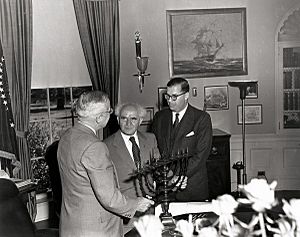
The United States has a history of recognizing Hanukkah. In 1951, Israeli Prime Minister David Ben-Gurion gave a Hanukkah Menorah to President Harry S. Truman. In 1979, President Jimmy Carter took part in the first public Hanukkah candle-lighting ceremony. This happened on the White House lawn. In 1989, President George H. W. Bush displayed a menorah in the White House. In 1993, President Bill Clinton invited schoolchildren to the Oval Office for a small ceremony.
The United States Postal Service has also released several Hanukkah-themed stamps. In 1996, they issued a Hanukkah stamp together with Israel. Later, in 2004, they released a stamp with a dreidel design. In 2009, a new Hanukkah stamp showed a menorah with nine lit candles.
Images for kids
-
A model of Jerusalem during the Second Temple Period
-
Maccabees on the Knesset Menorah
-
Public Hanukkiah lighting in Brussels next to the Berlaymont building, the headquarters of the European Commission, 2020
-
Second night of Hannukah at Jerusalem's Western Wall
See also
 In Spanish: Janucá para niños
In Spanish: Janucá para niños


